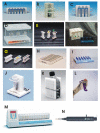Magnetic techniques for the isolation and purification of proteins and peptides
- PMID: 15566570
- PMCID: PMC544596
- DOI: 10.1186/1477-044X-2-7
Magnetic techniques for the isolation and purification of proteins and peptides
Abstract
Isolation and separation of specific molecules is used in almost all areas of biosciences and biotechnology. Diverse procedures can be used to achieve this goal. Recently, increased attention has been paid to the development and application of magnetic separation techniques, which employ small magnetic particles. The purpose of this review paper is to summarize various methodologies, strategies and materials which can be used for the isolation and purification of target proteins and peptides with the help of magnetic field. An extensive list of realised purification procedures documents the efficiency of magnetic separation techniques.
Figures

Similar articles
-
Use of magnetic techniques for the isolation of cells.J Chromatogr B Biomed Sci Appl. 1999 Feb 5;722(1-2):33-53. J Chromatogr B Biomed Sci Appl. 1999. PMID: 10068132 Review.
-
Recent advances in development of functional magnetic adsorbents for selective separation of proteins/peptides.Talanta. 2023 Feb 1;253:123919. doi: 10.1016/j.talanta.2022.123919. Epub 2022 Sep 8. Talanta. 2023. PMID: 36126523 Review.
-
Protein purification using magnetic adsorbent particles.Appl Microbiol Biotechnol. 2006 May;70(5):505-16. doi: 10.1007/s00253-006-0344-3. Epub 2006 Feb 23. Appl Microbiol Biotechnol. 2006. PMID: 16496138 Review.
-
A new look at xylanases: an overview of purification strategies.Mol Biotechnol. 2003 Jul;24(3):257-81. doi: 10.1385/mb:24:3:257. Mol Biotechnol. 2003. PMID: 12777693 Review.
-
Magnetic particles as powerful purification tool for high sensitive mass spectrometric screening procedures.Proteomics. 2010 Feb;10(4):628-33. doi: 10.1002/pmic.200900535. Proteomics. 2010. PMID: 20099258 Review.
Cited by
-
High performance wash-free magnetic bioassays through microfluidically enhanced particle specificity.Sci Rep. 2015 Jun 30;5:11693. doi: 10.1038/srep11693. Sci Rep. 2015. PMID: 26123868 Free PMC article.
-
Aptamer loaded superparamagnetic beads for selective capturing and gentle release of activated protein C.Sci Rep. 2022 Apr 30;12(1):7091. doi: 10.1038/s41598-022-11198-5. Sci Rep. 2022. PMID: 35490167 Free PMC article.
-
Magnetic One-Step Purification of His-Tagged Protein by Bare Iron Oxide Nanoparticles.ACS Omega. 2019 Feb 21;4(2):3790-3799. doi: 10.1021/acsomega.8b03348. eCollection 2019 Feb 28. ACS Omega. 2019. PMID: 31459591 Free PMC article.
-
Deterministic Ratchet for Sub-micrometer (Bio)particle Separation.Anal Chem. 2018 Apr 3;90(7):4370-4379. doi: 10.1021/acs.analchem.7b03774. Epub 2018 Mar 23. Anal Chem. 2018. PMID: 29506379 Free PMC article.
-
Highly efficient antibody purification with controlled orientation of protein A on magnetic nanoparticles.Medchemcomm. 2017 Nov 2;9(1):108-112. doi: 10.1039/c7md00468k. eCollection 2018 Jan 1. Medchemcomm. 2017. PMID: 30108904 Free PMC article.
References
LinkOut - more resources
Full Text Sources
Other Literature Sources

